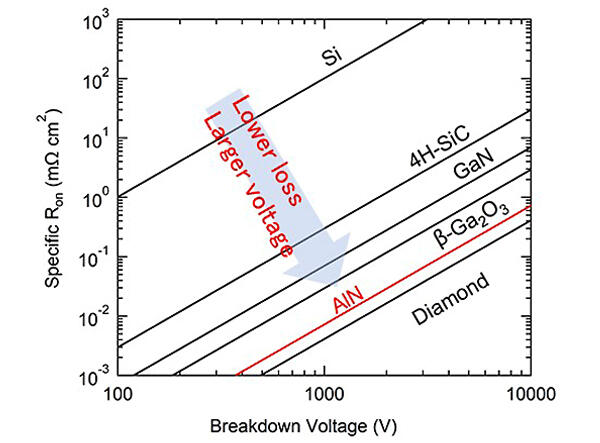
Provided by NTT
NTT has succeeded in operating the world's first transistor using aluminum nitride (AlN). They have developed a technology for fabricating high-quality AlN semiconductors by metal organic chemical vapor deposition (MOCVD) and an electrode structure with good ohmic and Schottky properties by establishing these elemental technologies. They also demonstrated that the developed transistors could operate at temperatures as high as 500°C.
AlN, an ultra-wide bandgap semiconductor, is a promising material for ultra-low loss power devices due to its large breakdown electric field. Transistors are used as semiconductor power devices to convert power in home appliances, electric vehicles and industrial equipment. Their low loss leads to reduced power consumption, which is an important achievement toward achieving carbon neutrality.
Silicon (Si) is the most commonly used semiconductor material in power devices, but the use of wide bandgap semiconductors with large breakdown electric fields as semiconductor materials will enable power devices with lower loss and higher breakdown voltage. For this reason, power devices are being developed using wide bandgap semiconductors such as silicon carbide (SiC) and gallium nitride (GaN). However, the use of ultra-wide bandgap semiconductors with larger breakdown electric fields than these is expected to further improve the performance of power devices. Such ultra-wide bandgap semiconductors include AlN, diamond, and gallium oxide (Ga2O3). These devices are theoretically expected to have power losses of less than 5% in Si, 35% in SiC, and 50% in GaN if power devices can be fabricated using AlN, which has one of the largest breakdown electric fields in semiconductors.
AlN has been used as an insulator since it was synthesized more than a century ago. In 2002, NTT was the first company in the world to successfully convert AlN into semiconductors, opening up the possibility of applying AlN to semiconductor devices. AlN has the advantage among ultra-wide bandgap semiconductors for being fabricated on large wafers suitable for industrial applications, as well as the ability to fabricate various device structures by forming heterojunctions with GaN. However, there have been few reports on AlN power devices and no excellent reports on their characteristics.
NTT has now successfully demonstrated transistor operation with good characteristics using high-quality AlN semiconductors fabricated by the MOCVD method. Its current-voltage characteristics showed a good linearity current rise due to ohmic characteristics and an extremely small leakage current. The breakdown voltage, important for the performance of power devices, also achieved a large value of 1.7kV. Furthermore, NTT found that this AlN transistor operates stably even at high temperatures.
Unlike conventional semiconductor materials, AlN transistors perform better at high temperatures, with current increasing about 100 times faster at 500°C than at room temperature. Even at the same temperature, the leakage current was limited to a tiny 10-8 A/mm. As a result, the AlN transistor exhibited a high on-off current ratio exceeding 106 even at 500°C.
NTT plans to further improve the properties of AlN semiconductors by forming heterojunctions and to demystify the physics of device operation at high temperatures with the aim of applying them to ultra-low-loss, high-voltage power devices and environmentally resistant devices.
This article has been translated by JST with permission from The Science News Ltd.(https://sci-news.co.jp/). Unauthorized reproduction of the article and photographs is prohibited.




